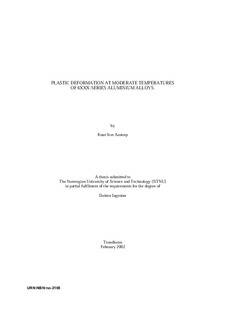| dc.contributor.author | Aastorp, Knut Iver | nb_NO |
| dc.date.accessioned | 2014-12-19T13:10:39Z | |
| dc.date.available | 2014-12-19T13:10:39Z | |
| dc.date.created | 2002-03-15 | nb_NO |
| dc.date.issued | 2002 | nb_NO |
| dc.identifier | 121829 | nb_NO |
| dc.identifier.isbn | 82-471-5404-8 | nb_NO |
| dc.identifier.uri | http://hdl.handle.net/11250/244450 | |
| dc.description.abstract | The present work has been carried out in order to investigate Al-Mg-Si alloys that are deformed at moderate temperatures. These temperatures are in the range between 200 C and 300 C. Also some experiments are performed at room temperatures. Two deformation models have been applied in the experiments: material deformation by compression testing and by forward extrusion.
The investigated alloys are AA6063, AA6082 and an alloy that is named “Alloy R” in this work. The latter alloy is the industrial alloy AA6082 without the Mn-addition (0.56wt%Mn in the AA6082). The “R” denotes the recrystallized microstructure in the material after hot forming operations.
The investigations show the effect of changing the temperature in the given temperature interval on the stress-strain relationship for each alloy. From the compression testing, it is found that none of the alloys AA6063 or Alloy “R” reaches a steady state condition as true strain approaches 0.8 for deformation temperatures between 200 C and 250 C. At compression testing performance at 300 C, the alloy “R” reaches a steady state condition at a true strain equal to 0.4.
As true stress-true strain relationship has been investigated for the “Alloy R” and the AA6063 at comparable deformation parameters, it is shown that the alloy “R”, with the highest Si-content, requires the highest true stress for a given true strain value (AA6063: 0.45wt%Si, Alloy “R”: 0.87wt%Si).
From the compression testing, the effect of Mn on the material properties in the AA6082-alloy has been determined. For the Alloy “R” and the AA6082, the true stress reached the same value after a certain amount of deformation. As deformation temperature increases, this common value of true stress corresponds to a decrease in true strain.
The AA6082 and Alloy “R” are also compared in experiments performed in forward extrusion. One observes that for the same deformation temperature and at identical die diameters, the ram force is identical. It is worth noticing that these alloys did not show the same relationship during the compression testing at low values of true strain (<0.8). On a microscopic scale, one concludes that Mn has no significant effect on the stress-strain relationship for the applied deformation parameters in the forward extrusion equipment.
Hardness measurements indicate that the age hardening potential in the extruded test specimen decreases as the deformation temperature increases. The hardness data is similar for both the AA6082 and the Alloy R, thus indicating that the Mn content has no significant effect on the strength of the material.
The deformed material has been annealed in order to investigate the recrystallization process in the AA6082 and the Alloy “R”. The recrystallization grain size in the Alloy “R” is significantly larger than in the AA6082 at comparable deformation parameters after annealing at 530 C for 15 minutes. This result is due to the effect of Mn-containing dispersoids in the AA6082. The recrystallization grain size in the Alloy “R” seems to be unaffected by the deformation temperature after annealing for 15 minutes. The observation of the AA6082 is quite different. A small increase in grain size is observed for both reduction ratios as the deformation temperature is elevated from 20C to 200 C and further to 250 C. At extrusion temperatures of 300 C the recrystallization grains are significantly larger.
Annealing experiments performed at 430 C on the AA6082 indicates that a change in the deformation temperature from 200 C to 250 C does not affect the amount of stored energy in the material significantly.
The Forge2 programme has been used to perform numeric simulations of the forward extrusion experiment. From this the temperature distribution, strain rate variation and true strain development in the test piece had been investigated. As the simulated true strain values are compared to the grain size in the annealed material, the recrystallization grain size is related to the amount of stored energy in the material in a very convincing way. It is also shown that the recrystallization grain diameter is related to the amount stored energy as the grain diameter is investigated in the radial and the extrusion direction separately. | nb_NO |
| dc.language | eng | nb_NO |
| dc.publisher | Fakultet for naturvitenskap og teknologi | nb_NO |
| dc.relation.ispartofseries | Dr. ingeniøravhandling, 0809-103X; 2002:12 | nb_NO |
| dc.subject | | en_GB |
| dc.subject | Materialvetenskap | en_GB |
| dc.subject | TECHNOLOGY: Materials science | en_GB |
| dc.title | Plastic Deformation at Moderate Temperatures of 6XXX-series Aluminium Alloys | nb_NO |
| dc.type | Doctoral thesis | nb_NO |
| dc.source.pagenumber | 124 | nb_NO |
| dc.contributor.department | Norges teknisk-naturvitenskapelige universitet, Fakultet for naturvitenskap og teknologi | nb_NO |
| dc.description.degree | dr.ing. | nb_NO |
| dc.description.degree | dr.ing. | en_GB |
